Page 124 of 340
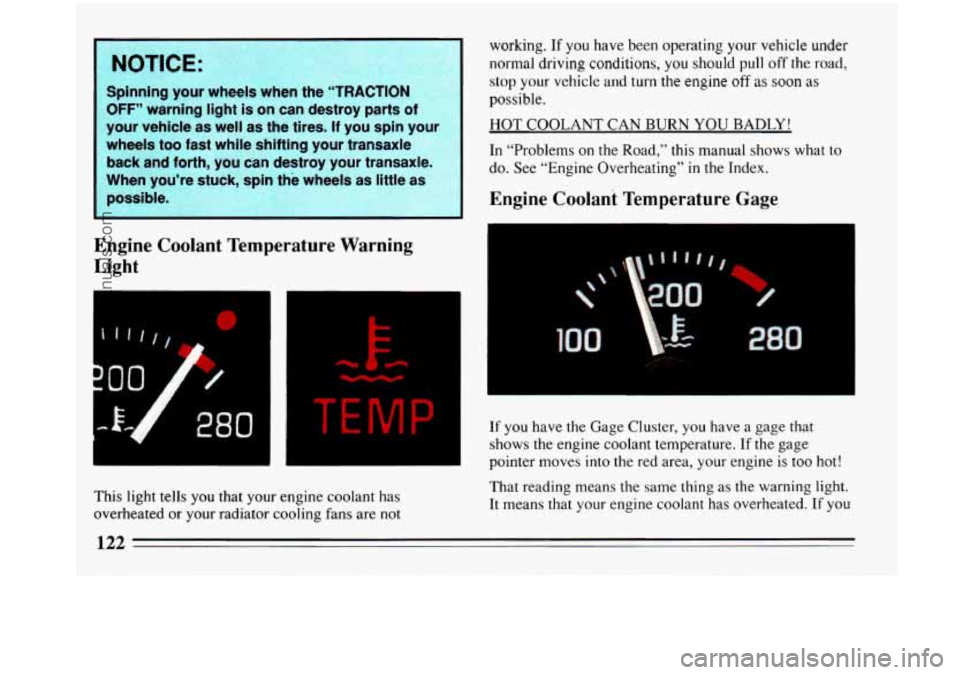
I NOTICE:
Spinning your wheels when the “TRACTION
OFF” warning light is on can destroy parts of
your vehicle as well as the tires.
If you spin your
wheels too fast while shifting your transaxle
back and forth, you can destroy your transaxle.
When you’re stuck, spin the wheels
as little as
possible.
~~~~~~
1
working. If you have been operating your vehicle under
normal driving conditions,
you should pull off the road,
Engine Coolant Temperature Warning
Light
7
280
stop your vehicle and turn the engine off as soon as
possible.
HOT COOLANT CAN BURN YOU BADLY!
In “Problems
on the Road,” this manual shows what to
do. See “Engine Overheating”
in the Index.
Engine Coolant Temperature Gage
100
.Id pointer moves into the red area, your engine is too hot!
If you have the Gage Cluster, you have a gage that
shows the engine coolant temperature.
If the gage
This light
tells you that your engine coolant has
overheated or your radiator cooling fans are
not
That reading means the same thing as the warning light.
It means that your engine coolant has overheated.
If you
122
ProCarManuals.com
Page 134 of 340
CooVWarm Off
r--
i
c F
To choose the temperature you want maintained inside
the car, push one of these.
You can choose from 60 OF (16 "C), for maximum
cooling, and
90" F (33 "C), for maximum heating. It is
not necessary to choose the extreme temperature to get
the system to heat
or cool at the maximum. The system
does
it automatically.
E
Til
When the system is off, the ventilation system will allow
air to flow through your Buick when the vehicle
is
moving. The system will try to keep the air at the chosen
temperature, unless
it is very hot or very cold. The
outside temperature will show in the display area when
the system is
OFF.
ProCarManuals.com
Page 137 of 340
Econ Defog
Htr
You can use ECON when
you don't need to cool the
outside air. The system will
work like the AUTO mode
without cooling. The air
flow will come from the
instrument panel outlets.
ECON does not have the
blower delay feature as the
AUTO mode setting.
L
E HTR E
To warm the air, press '
and adjust the temperature
and fan speed for your
comfort. Most
of the air
will come from the floor
outlets.
la
c I
When the outside
temperature is mild, use
DEFOG to keep fog off the
windshield.
Air entering the vehicle will be evenly split between the
floor outlets and the outlets near the windshield.
The blower speed will be controlled automatically, but
you can choose another fan speed by pushing the
HI or
LO buttons.
135
ProCarManuals.com
Page 139 of 340
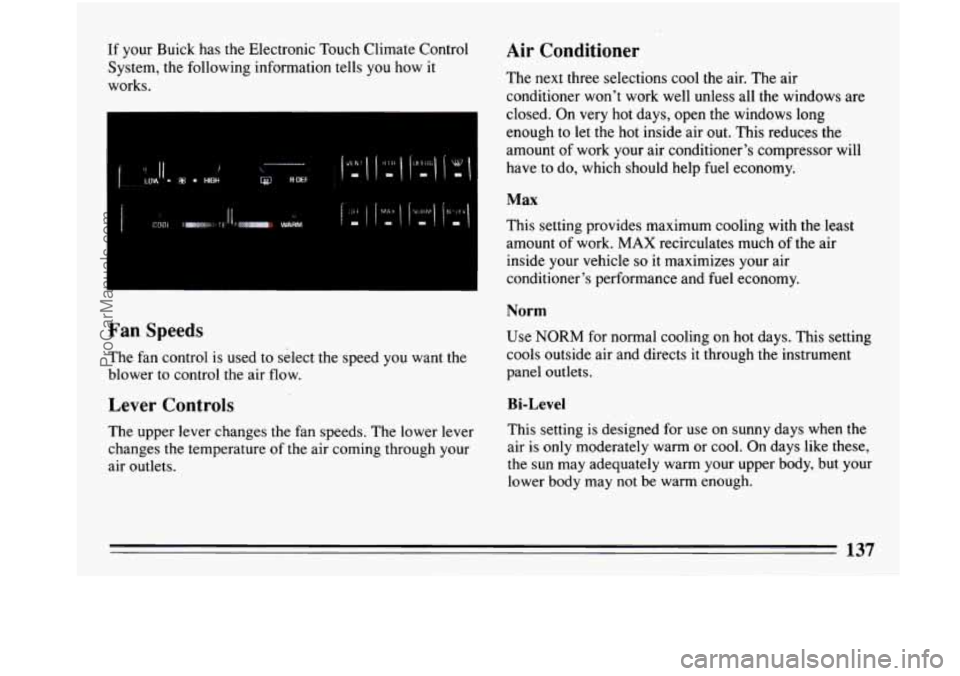
If your Buick has the Electronic Touch Climate Control
System, the following information
tells you how it
works.
Air Conditioner
The next three selections cool the air. The air
conditioner won't work well unless all the windows are
1 closed. On very hot days, open the windows long ~
~ ~ enough to let the hot inside air out. This reduces the
i amount of work your air conditioner's compressor will
have to do, which should help fuel economy.
Max
This setting provides maximum cooling with the least
amount of work.
MAX recirculates much of the air
inside your vehicle
so it maximizes your air
conditioner's performance and fuel economy.
Fan Speeds
The fan control is used to select the speed you want the
blower to control
the air flow.
Lever Controls
The upper lever changes the fan speeds. The lower lever
changes the temperature of the air coming through your
air outlets.
Norm
Use NORM for normal cooling on hot days. This setting
cools outside air and directs
it through the instrument
panel outlets.
Bi-Level
This setting is designed for use on sunny days when the
air
is only moderately warm or cool. On days like these,
the sun may adequately warm your upper body, but your
lower body may not be warm enough.
ProCarManuals.com
Page 140 of 340
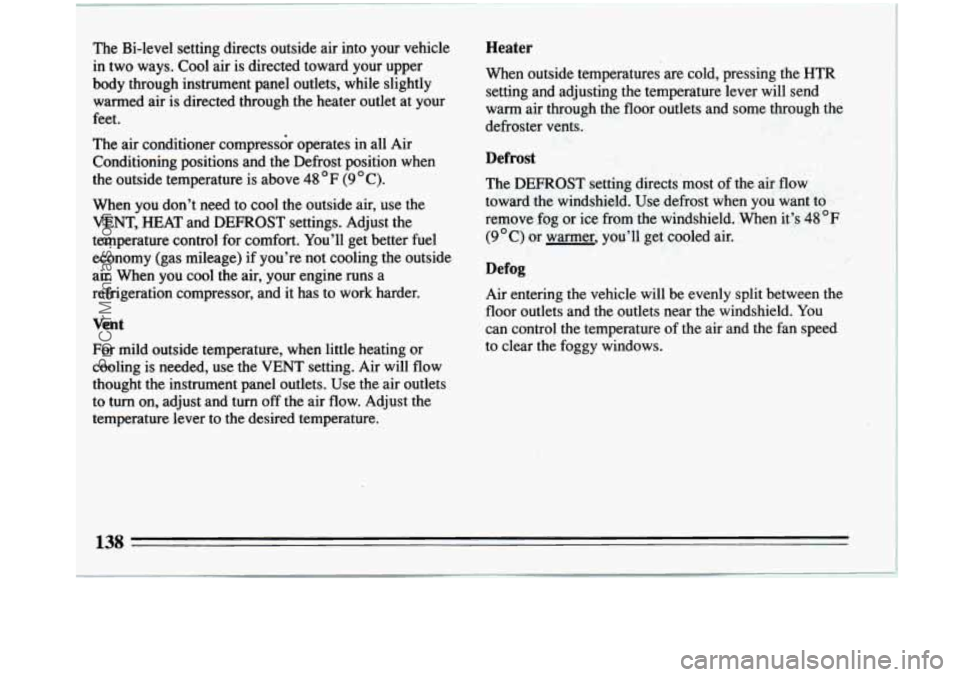
The Bi-level setting directs outside air into your vehicle
in two ways. Cool air is directed toward your upper
body through instrument panel outlets, while slightly
warmed air is directed through the heater outlet at your
feet.
The air conditioner compress& operates in all Air
Conditioning positions and the Defrost position when
the outside temperature is above
48 OF (9 “C).
When you don’t need to cool the outside air, use the
VENT, HEAT and
DEFROST settings. Adjust the
temperature control for comfort. You’ll get better fuel
economy (gas mileage) if you’re not cooling the outside
air. When you cool the air, your engine runs a
refrigeration compressor, and it has to work harder.
Vent
For mild outside temperature, when little heating or
cooling is needed, use the
VENT setting. Air will flow
thought the instrument panel outlets. Use the air outlets
to turn on, adjust and turn
off the air flow. Adjust the
temperature lever
to the desired temperature.
Heater
When outside temperatures are cold, pressing the HTR
setting and adjusting the temperature lever will send
warm air through the floor outlets and some through the
defroster vents.
Defrost
The DEFROST setting directs most of the air flow
toward the windshield. Use defrost when you want to
remove
fog or ice from the windshield. When it’s 48OF
(9 * C) or warmer, you’ll get cooled air.
Defog
Air entering the vehicle will be evenly split between the
floor outlets and the outlets near the windshield. You
can control the temperature of the air and the fan speed
to clear the foggy windows.
138
ProCarManuals.com
Page 194 of 340
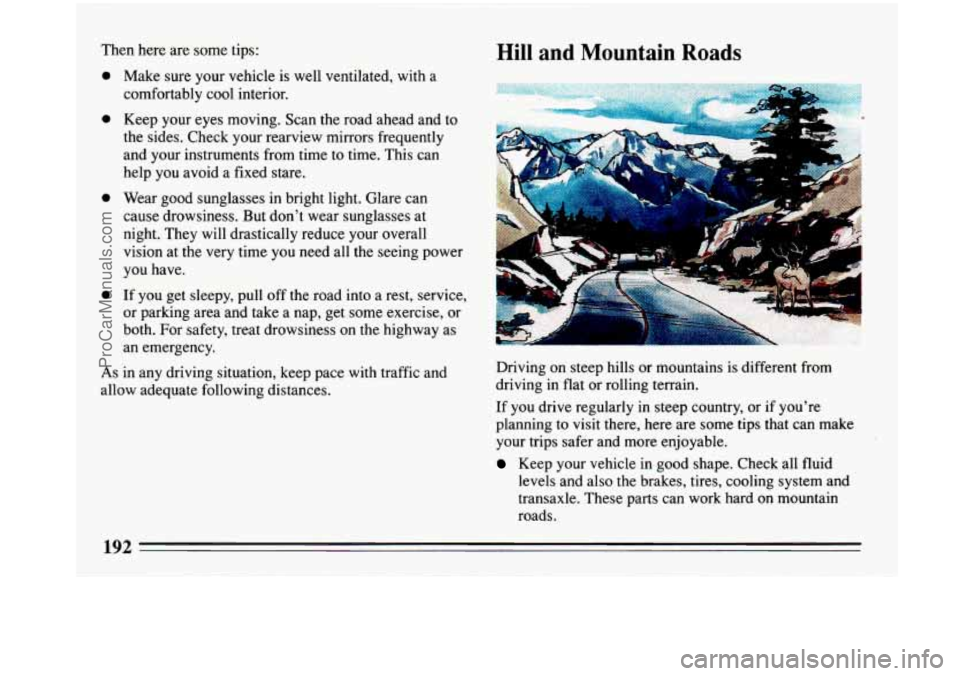
Then here are some tips:
e
e
e
e Make sure your vehicle is well ventilated, with a
comfortably cool interior.
Keep your eyes moving. Scan the road ahead and to
the sides. Check your rearview mirrors frequently
and your instruments from time
to time. This can
help you avoid
a fixed stare.
Wear
good sunglasses in bright light. Glare can
cause drowsiness. But don't wear sunglasses at
night. They will drastically reduce your overall
vision at the very time you need all the seeing power
you have.
If you get sleepy, pull off the road into a rest, service,
or parking area and take a nap, get some exercise, or
both. For safety, treat drowsiness
on the highway as
an emergency.
As in any driving situation, keep pace with traffic and
allow adequate following distances. Driving on
steep hills or mountains is different from
driving in flat or rolling terrain.
If you drive regularly
in steep country, or if you're
,planning to visit there, here are some tips that can make
your trips safer and more enjoyable.
Keep your vehicle in good shape. Check all fluid
levels and also the brakes, tires, cooling system and
transaxle. These parts can work hard
on mountain
roads.
192
ProCarManuals.com
Page 209 of 340
When You Are Ready to Leave After
Parking on
a Hill
1. Apply your regular brakes and hold the pedal down
while you:
Start your engine;
0 Shift into a gear; and
0 Release the parking brake.
2. Let up on the brake pedal.
3. Drive slowly until the trailer is clear of the chocks.
4. Stop and have someone pick up and store the chocks.
Maintenance When Trailer Towing
Your vehicle will need service more often when you’re
pulling a trailer. See the Maintenance Schedule for more
on this. Things that are especially important in trailer
operation are automatic transaxle fluid (don’t overfill),
engine oil, belt, cooling system, and brake adjustment.
Each
of these is covered in this manual, and the Index
will help
you find them quickly. If you’re trailering, it’s
a good idea to review these sections before
you start
your trip.
Check periodically to see that all hitch nuts and bolts are
tight.
ProCarManuals.com
Page 225 of 340
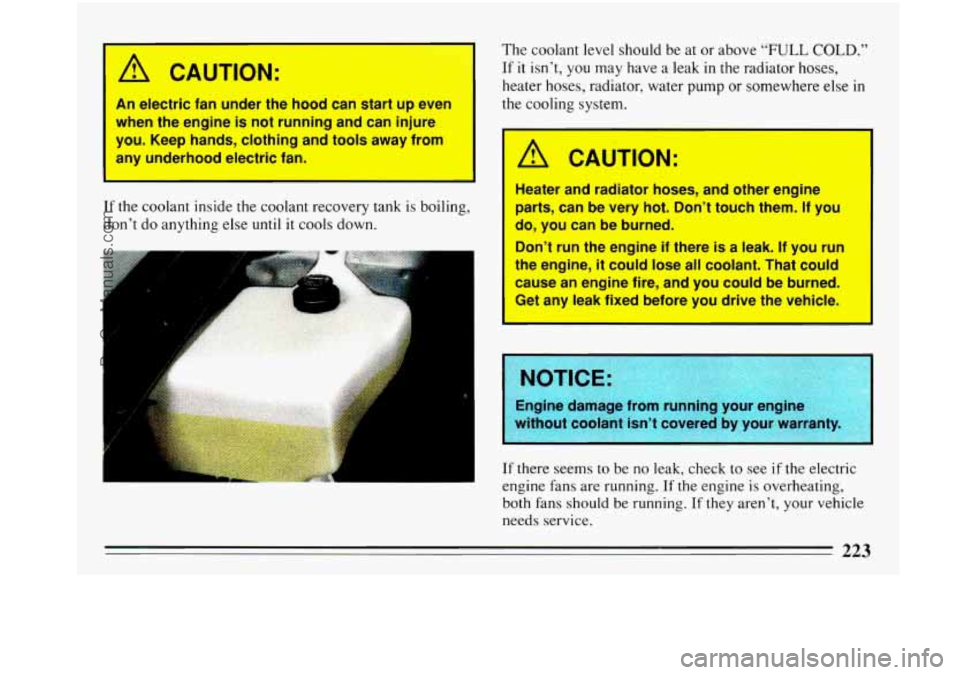
I A CAUTION:
An electric fan under the hood can start up even
when the engine
is not running and can injure
you. Keep hands, clothing and tools away from
any underhood electric fan.
If the coolant inside the coolant recovery tank is boiling,
don’t do anything else until it cools down.
. .” P
The coolant level should be at or above “FULL COLD.”
If it isn’t, you may have a leak in the radiator hoses,
heater hoses, radiator, water pump
or somewhere else in
the cooling system.
I I
A CAUTION:
Heater and radiator hoses, and other engine
parts, can be very hot. Don’t touch them.
If you
do, you can be burned.
Don’t run the engine
if there is a leak. If you run
the engine, it could lose all coolant. That could
cause an engine fire, and you could be burned.
Get any leak fixed before you drive the vehicle.
I
Engine damage? Il’onl I mning bUrlr engine
without coolant isn’t covered by your warrbllr
If there seems to be no leak, check to see if the electric
engine fans are running. If the engine
is overheating,
both fans should be running. If they aren’t, your vehicle
needs service.
223
ProCarManuals.com